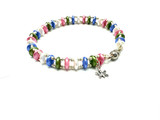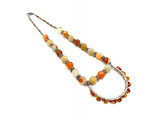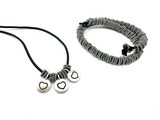Riveting 101
 Learn the basics of riveting, including how to distinguish various types of rivets and how to set different rivets.
Learn the basics of riveting, including how to distinguish various types of rivets and how to set different rivets.
Riveting is a classic, durable and popular way to create cold connections in jewelry designs (a "cold connection" is the joining together of metal components without using solder).
Each type of rivet used to make jewelry requires different tools and techniques. Discover these methods below. Once you're ready to create your own custom riveted jewelry, check out our full line of rivets, eyelets, and riveting tools.
Table of ContentsCompression RivetsNail-Head Rivets Semi-Tubular Rivets Faux Rivets Wire Rivets Eyelets | |
 | Compression Rivets (2-Part Rivets)Also known as two-part rivets, compression rivets come in sets with a top and bottom. Typically used with leather, compression rivets are thicker than most wire rivets and are easy to set with just a few supplies. To set compression rivets, follow the infograph and use the following tools: 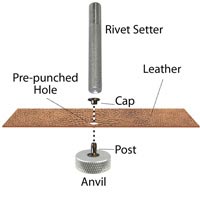
For more information, see:
|
  | Nail-Head RivetsNail-head rivets work the same way wire rivets do, except that they have one end already finished. This decreases the amount of labor needed to set them. They can be cut to shorter lengths if necessary, then set by hammering the unfinished end. 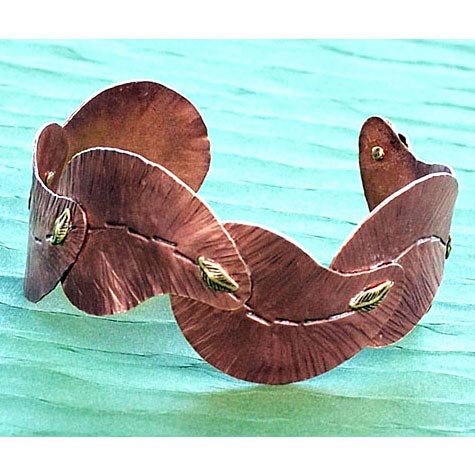 Decorative rivets (aka fancy wire rivets) are nail-head rivets with decorative motifs on the finished end. To avoid damaging the decorative end, use a wooden block instead of a metal block to set fancy rivets (a scrap piece of 2x4" works perfectly). Or, place a scrap of leather between the decorative head and the metal block when hammering. A bare steel block will damage the finished side of the rivet. Decorative rivets (aka fancy wire rivets) are nail-head rivets with decorative motifs on the finished end. To avoid damaging the decorative end, use a wooden block instead of a metal block to set fancy rivets (a scrap piece of 2x4" works perfectly). Or, place a scrap of leather between the decorative head and the metal block when hammering. A bare steel block will damage the finished side of the rivet. For a full tutorial on how to set decorative rivets, see our blog post "How to Use Fancy Wire Rivets". Nail-head rivets and decorative rivets work best on metal. To use this type of rivet with leather, place washers/spacers between the leather and the rivet heads (both sides) to hold the rivets in place. Otherwise, the small heads on these rivets tend to pull right through pliable materials like leather. |
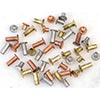 | Semi-Tubular Rivets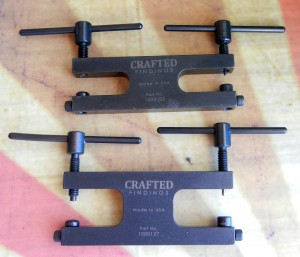 Semi-tubular rivets look similar to the "cap" portion of two-part rivets, but they work differently. With semi-tubular rivets, most of the rivet is solid wire, but the final approximately 2mm (at the tail, the opposite end from the rivet's head) opens up into a tube, rather like an eyelet. Crafted Findings riveting system uses surprisingly gentle pressure to compress this tubular portion into a neat, clean, secure tail. Crafted Findings' innovative tool system allows you to punch holes and set rivets with the same tool base. Both rivets and eyelets are set with a screw-action mechanism, which means no loud tapping or hammering. The process is also much quicker than traditional jeweler-style wire riveting, saving you oodles of time (several of us at Rings & Things have become Crafted Findings addicts!). Semi-tubular rivets look similar to the "cap" portion of two-part rivets, but they work differently. With semi-tubular rivets, most of the rivet is solid wire, but the final approximately 2mm (at the tail, the opposite end from the rivet's head) opens up into a tube, rather like an eyelet. Crafted Findings riveting system uses surprisingly gentle pressure to compress this tubular portion into a neat, clean, secure tail. Crafted Findings' innovative tool system allows you to punch holes and set rivets with the same tool base. Both rivets and eyelets are set with a screw-action mechanism, which means no loud tapping or hammering. The process is also much quicker than traditional jeweler-style wire riveting, saving you oodles of time (several of us at Rings & Things have become Crafted Findings addicts!). Crafted Findings riveting tools are made in the USA of durable heat-treated steel. They come in options for 1/16" diameter or 3/32" diameter rivets and eyelets. They also come in a choice of "original" or "long reach" sizes. The long reach tools allow you to rivet thicker layers together (i.e. the "reach" is height, not depth from edge to center). EZ-Rivet® tools, imported by the BeadSmith®, set rivets using the same type of screw-action mechanism as Crafted Findings. EZ-Rivet tools come in sizes for 1/16" or 3/32" diameter rivets, and they work with all of our 1/16" and 3/32" semi-tubular rivets. The EZ-Rivet is a good entry-level tool for setting 1/16" and 3/32" semi-tubular rivets, but the Crafted Findings tools have more options, and are smoother to use. As with nail-head rivets, semi-tubular rivets work best on metal. To use Crafted Findings rivets with leather, place washers/spacers between the leather and the back of the rivets, to hold the rivets in place — as in our Winged Heart Hat Band design. Option: you can include washers on both sides of the rivet for a decorative effect, like in our "Tschinkel's Circles" bracelet design. For more information on Crafted Findings and semi-tubular rivets, see:
|
Faux Riveting with Head Pins | |
 | Wire RivetsWire rivets are classic, traditional rivets handmade with wire and a hammer. This "old-school" style of riveting is a wonderful skill to develop, but it's time-consuming to do properly. The rivets themselves are simply wire — made from any gauge of malleable wire, in any length you need. Here's a summary of the process with links to tools and supplies: 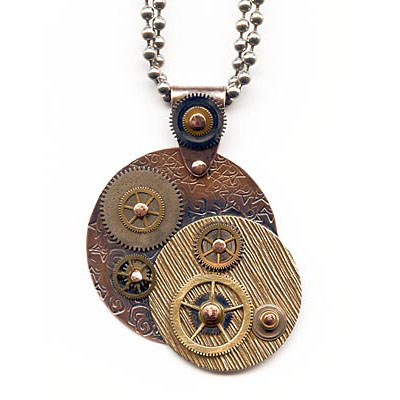
For more information, see:
|
 | EyeletsEyelets are tubes with flared ends. Jewelers sometimes refer to them as tube rivets. One end of a semi-tubular rivet even looks like an eyelet! The main difference between a rivet and an eyelet is that you can see all the way through an eyelet after you set it, but at least one end of a rivet is always solid. If the eyelet is large enough, you can also run wire, chain or a jump ring through the resulting reinforced hole -- see the purple "Spiris" pendant (pictured at right). As with rivets, eyelets come in various sizes and styles: 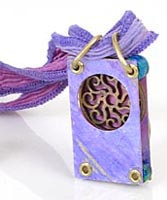 3/16" diameter eyelets are large and generally used for leather. To set eyelets in leather, use an eyelet setter and the same basic method used to set compression rivets (see above). 3/16" diameter eyelets are large and generally used for leather. To set eyelets in leather, use an eyelet setter and the same basic method used to set compression rivets (see above). Crafted Findings eyelets come in 1/16" and 3/32" diameters and many lengths. Normally you set them with the Crafted Findings tool system (more details above, in the semi-tubular rivets section), but you can also set them by hand, using the steps below -- but skip the steps that explain how to cut tubing, since Crafted Findings eyelets are already cut to a variety of popular lengths. To create your own custom eyelets using metal tubing, and set them using common jewelry tools:
For more information, see:
|
Our Bead Blog
-
Simply Springy 2-Hole Bracelet
Apr 28th 2025Designed by: Guest Designer Deb Floros Suggested Supplies 1 #61-840-50-01 Beadalon Cord, WildFire,
-
Exotic Statement Necklace
Apr 28th 2025Designed by: Guest Designer Deb Floros Suggested Supplies 1 #88-400-003-5 58x50mm Pewter Connector,
-
Rubber Tubing Necklace and Memory Wire Bracelet Set
Mar 21st 2025Designed by: Guest Designer Deb Floros Suggested Supplies 1 #61-622-02 2mm Rubber Cord, Bulk, for J


